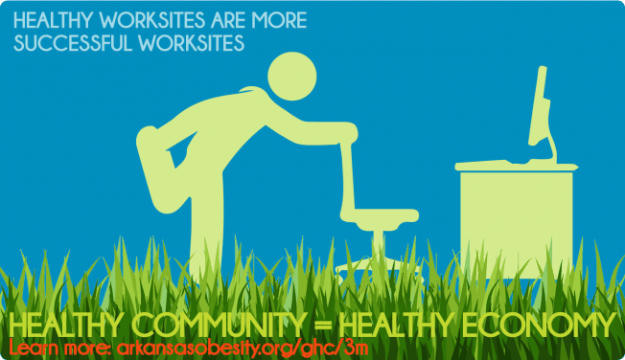
Employees spend around a quarter of each week at work – about a third, if you take sleeping hours out of the equation. So the way worksites and employers view wellness will have an incredible effect on their employees and the larger community.
Healthy Worksites are More Successful

A healthy workforce translates to happier, more efficient workers and lower health-care related costs to employers.
- CDC Worksite Wellness – A positive wellness culture in the workplace contributes to the physical, mental, and emotional well-being of workers. The workplace becomes more productive and constructive when employers integrate breaks for rejuvenation. It also helps to establish clear and reasonable roles and responsibilities and respect the time and talents of individuals and their non-work demands. These steps provide the organization with more opportunity to reduce the number of sick days and health-associated costs. Are you working to make your office a healthy place for yourself and your colleagues?
- CDC National Healthy Worksite Program – The National Healthy Worksite Program is designed to assist employers in implementing science and practice-based prevention and wellness strategies that will lead to specific, measurable health outcomes to reduce chronic disease rates. For most employers, chronic diseases—such as heart disease, stroke, cancer, obesity, arthritis and diabetes—are among the most prevalent, costly, and preventable of all health problems. The National Healthy Worksite Program seeks to promote good health through prevention, reduce chronic illness and disability, and improve productivity outcomes that contribute to employers’ competitiveness.
- CDC Workplace Health Promotion – This site is a toolkit for workplace health promotion and protection professionals. Use this site to learn about how to design, implement, and evaluate effective workplace health programs.
- CDC Worksite Health ScoreCard – The CDC Worksite Wellness ScoreCard is an evidence-based assessment tool that enables employers to assess the work environment to develop effective worksite wellness programs and policies that address prevention of chronic diseases such as heart disease, stroke, and related conditions such as hypertension, diabetes, and obesity. Use the online scorecard or contact Katrina Betancourt for a smartphone app!
- CDC Work@Health Program – Work@Health® is an employer-based training program. The ultimate aim of the program is to improve the organizational health of participating employers and certified trainers, with an emphasis on strategies to reduce chronic disease and injury risk to employees and an eye to improving overall worker productivity.
- CDC Workplace Health Model – A coordinated approach to workplace health promotion results in a planned, organized, and comprehensive set of programs, policies, benefits, and environmental supports designed to meet the health and safety needs of all employees. A comprehensive approach looks to put interventions in place that address multiple risk factors and health conditions concurrently and recognizes that the interventions and strategies chosen influence multiple levels of the organization including the individual employee and the organization as a whole.
- HEAL Cities Campaign Workplace Wellness Policies & Committees – Some cities have passed resolutions requiring a focus on workplace wellness. Others have established wellness committees that assess the nutrition and physical activity environment within the workplace, survey employees about their needs and interests, implement programs and recommend policy changes.
- ADH Worksite Wellness – One of the focus areas of the Healthy Communities Domain is in worksites wellness which provides technical assistance and guidance in worksite interventions to promote health. This area is a resource for identifying trends and best practices in worksite wellness as well as for developing community and organization level worksite programs, systems, and procedures.
- Arkansas Healthy Employee Lifestyle Program (AHELP) – AHELP is a worksite wellness intervention designed for State Agency, Boards, and Commissions. The mission is to create a worksite culture that supports healthy lifestyle choices for state employees.
- Community Healthy Employee Lifestyle Program (CHELP) – Community Healthy Employee Lifestyle Program (CHELP) is a worksite wellness intervention designed for non-state worksites.
- Worksite Wellness Presentation – The case for employee wellness programs.
- WELCOA – The Wellness Council of America is one of the nation’s most-respected resources for building high-performing, healthy workplaces. Over its 25+ year history, WELCOA has perfected its patented Well Workplace protocol which is the key to developing, delivering, and sustaining a healthy corporate culture. Whether you are a workplace wellness practitioner, human resources professional, business leader, or consultant/broker, WELCOA’s tools, trainings, and resources will help you better promote organizational well-being and, at the same time, contain escalating health care costs.
- Easy Steps for Supporting Breastfeeding Employees – The Business Case for Breastfeeding: Steps for Creating a Breastfeeding Friendly Worksite is designed for human resource managers and staff interested in implementing a lactation support program. Return on investment (ROI) is the bottom line in assessing the value of new programs. Research shows that providing a lactation support program is not only highly desired by breastfeeding employees who return to work after childbirth, it can also improve your company’s ROI by saving money in health care and employee expenses.
- Eat Smart Move More NC’s Wellness Committee Guide – The WorkWell NC Wellness Committee Guide provides the resources and tools for worksite wellness committees to establish, maintain and sustain a successful worksite wellness program.
- Wellness Institute Worksite Wellness Certifications – the National Wellness Institute offers the Certified Worksite Wellness Specialist (CWWS) and Program Manager (CWWPM) certification programs. These programs are intended to give the worksite wellness professional the knowledge and tools needed to carry out successful worksite wellness programs. The most current information and research in the field of health promotion and wellness is used to teach participants how to change an organization’s culture to ensure long-term results.
- ACE Fitness Fostering a Workplace Culture of Physical Activity – Whether you’re a small business owner, a corporate human resources manager, or a front-line supervisor, promoting physical activity on the job makes sense. More opportunities for physical activity at work leads to healthier employees, stronger job performance, and a boost to the business bottom line via decreased health care costs and improved productivity.
- Healthy Food Choices In the Work Place – Offering healthy food and beverage choices in the workplace can make a huge impact on the health, productivity, and overall well-being of employees. To help encourage healthier choices, establish food and beverage guidelines for all organizational meetings, events and on-site vendors. In addition, consider providing nutrient-rich food and beverage choices in the cafeteria and vending machines.
- National Alliance for Nutrition and Activity Healthy Meeting Toolkit – This toolkit is intended for anyone that holds meetings and conferences. It could be used by governments, non-profits, associations, businesses, or as an option for hotel chains or conference centers. This resource is a model that can be modified to fit the specific needs of the organization using it.
- Pass Anti Tobacco & e-Cigarette Policies, Get Free Signs – Adopt or expand anti tobacco and e-cigarette policies, get free signage! ADH’s Tobacco Prevention & Cessation Program (TPCP) is one of ArCOP’s strategic partners because we’re both seeking healthier communitites – and tobacco- and e-cigarette-free communities are healthier for those who live, work, play, and pray in them. TPCP has funds available to help city governments, businesses, churches, communities pass tobacco and e-cigarette-free policies. Then, after a community has done so, TPCP will provide free signage to make it easy for everyone to be aware of your policies.



